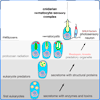A view to kill
- PMID: 22390773
- PMCID: PMC3293708
- DOI: 10.1186/1741-7007-10-18
A view to kill
Abstract
Genome and proteome data from Hydra magnipapillata have opened the way for the molecular analysis of an ancient nervous system, which includes stinging cells, an unusual neurosensory and neurosecretory cell type. They hold some surprises for the mechanisms and evolution of sensory transduction that could not have been anticipated from what has been learned from flies and vertebrates. Research in BMC Biology now implicates the ancient opsin-mediated transduction pathway in the neuronal control of stinging cell discharge.
Figures


Comment on
-
Cnidocyte discharge is regulated by light and opsin-mediated phototransduction.BMC Biol. 2012 Mar 5;10:17. doi: 10.1186/1741-7007-10-17. BMC Biol. 2012. PMID: 22390726 Free PMC article.
References
-
- Thorington GU, McAuley V, Hessinger DA. Effects of satiation and starvation on nematocyst discharge, prey killing, and ingestion in two species of sea anemone. Biol Bull. 2010;219:122–131. - PubMed
Publication types
MeSH terms
Substances
LinkOut - more resources
Full Text Sources

